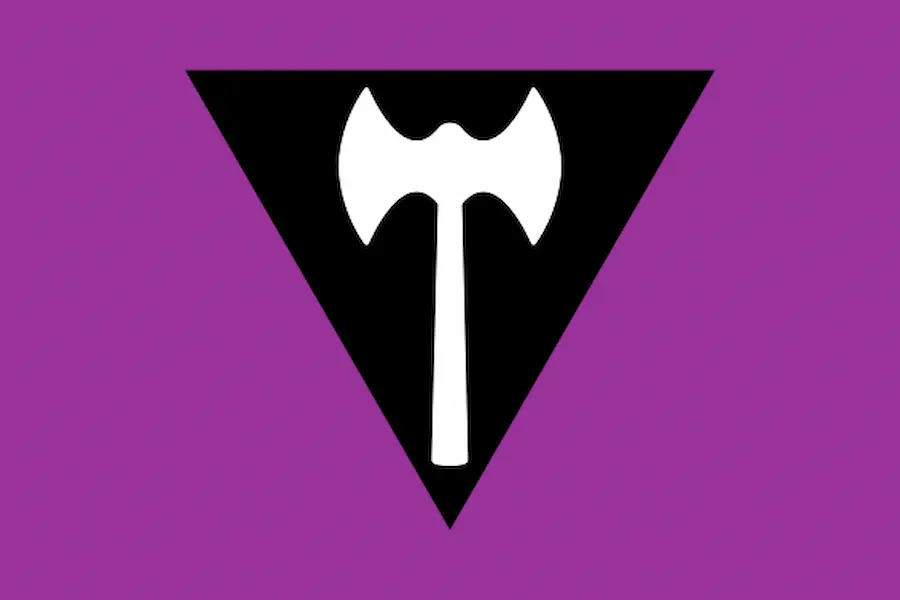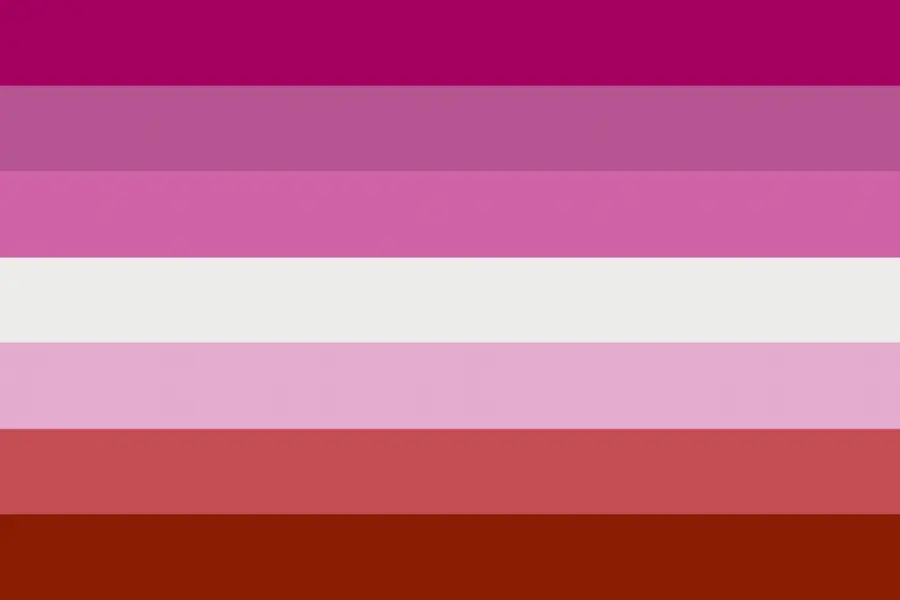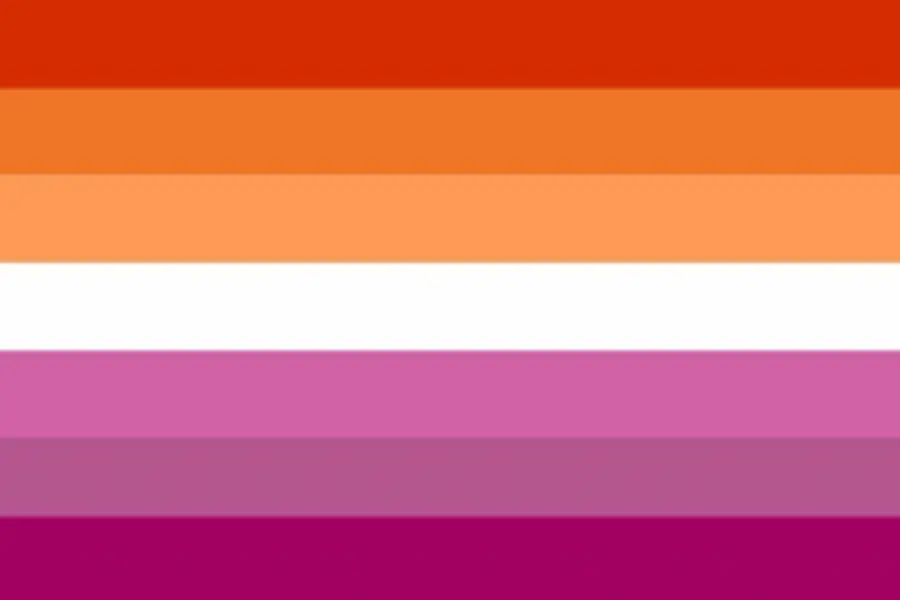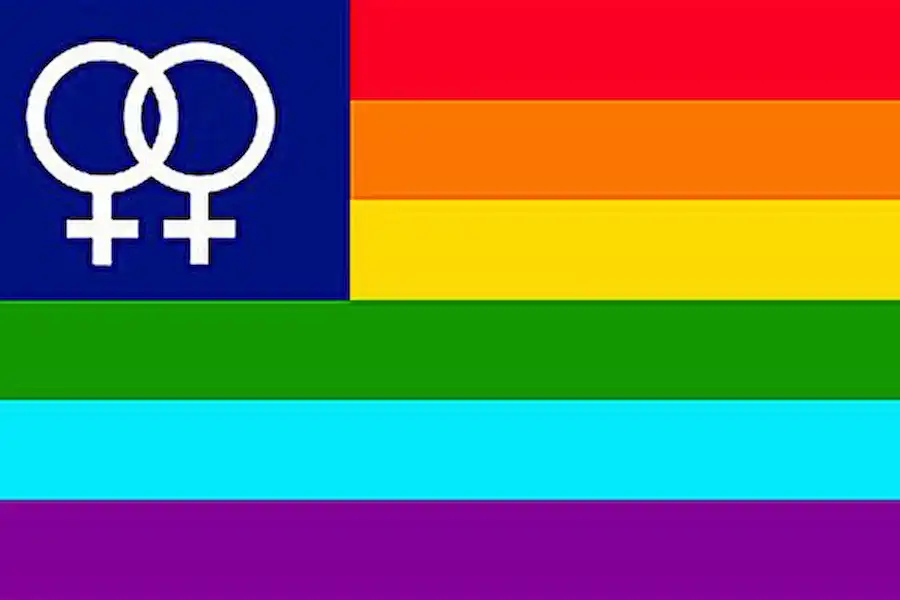The lesbian flag appears to have had the most alterations in design, color, symbolism, and other aspects of all the LGBT flags. If you are a lesbian or merely support this sexuality during Pride Month, knowing what each form of these flags represents can help you identify which one your ideals belong to.
Above all, you don’t want to fly one about which you have no idea. So, read on to find out what these lesbian pride flags are and what they imply!

The first lesbian pride flag was designed in 1999 by graphic designer Sean Campbell. It features a double-edged ax on an inverted triangle, and the backdrop is purple.
Although Campbell is not a female (he is a gay transgender man), his design carries significant lesbian meaning and history. However, it has faced many objections until now. That’s because the black upside-down triangle on this desgin refers to the Holocaust event. Specifically, the Nazis used a black upside-down triangle to mark gay women during the second world war.
In terms of the violet backdrop, the meaning of this color is said to come from a line in Sappho‘s poem “I Have Not Had One Word From Her”. In this line, she describes all the gorgeous women in her area wearing violet tiaras. And for it, all the 1920s’ lesbians refer to the violet as their symbol.
Concerning the axe, which is also called the labrys (building the name of this flag), it comes from Greek mythology and early history. This symbol represents the power of feminism of homosexual females (including Greek Gods and ordinary people). Later then in the 1970s, people began using it as the symbol of the lesbian community.

Natalie McCray designed the lipstick lesbian pride flag, first made public in 2010 on the blog This Lesbian Life. It has become a well-known symbol for lesbians worldwide, appearing in everything from television shows (such as Orange Is the New Black) to lesbian magazines.
It has six horizontal pink-hued bars with a white stripe in the middle. The red lipstick is depicted in the upper left corner.

When it comes to lesbian flags, many people today may think of the one with red lipstick mark. It is, however, not so many of them fly it. Instead, they use the same design but without the image of lipstick on it.
Indeed, lipstick can never define their sexuality. What about homosexual women who do not wear it? So, it was considered stereotyped and subjective to represent the community of all queer women.

In 2018, Natalie turned out to be a transphobe, biphobe, and racist. As a result, another version of the flag appeared on Emily Gwen’s Tumblr Blog in the same year. Without the red lipstick and with new layouts, colors, and symbolism, it has had the hearts of most lesbians.
Let’s break down its symbolism:
Today, two lesbian pride flag variations have appeared on social networking sites and gone viral. Besides the four versions introduced above, you can easily see them in Pride Month parades.

One of them is believed to have come from the flag raised by Emily Gwen. It came to the public (in 2019) as a shortened version of the seven-striped lesbian pride flag. Specifically, the current version has only five stripes, including two orange stripes, two pink stripes, and one white stripe in the middle.
Despite the change in layout, it remains the same meanings and symbolism. Therefore, there is no reason that lesbians won’t use it widely today.

A variation of the gay pride rainbow flag with the double-Venus symbol in the upper left corner is another version to look at. The truth is that no one knows where it came from. In some ways, however, some queer women and their ally supporters have always used it because they identify with what it stands for.
None of the flags listed above are superior to the others. What they have in common is the lesbian community’s symbolism in general. However, determining which one is most appropriate is a matter of personal preference and value. That is, one might believe, for example, that the five-stripe lesbian pride flag is the only one appropriate for queer females. He can’t, however, make anyone believe or admit it.
As a result, finding the right flag for you necessitates delving into each version’s history and determining its worth. You’ll know what’s right for you once you feel truly connected to it.
We’ve always understood that it’s the right thing to do with a new lesbian flag that gets the nod from many people. At least it doesn’t send you the FOMO effect during a Pride parade. However, if you are a fan of creativity and uniqueness as Flagwix always does with all flags, consider the designs below:
Lesbians are part of a rich tapestry of human sexuality. More than anything, they deserve to be treated equally. In order to do that, it’s essential to know how we came to where we are today as members of society who strive for equality.
There’s no better way to honor our movement than by knowing how one little lesbian flag could inspire thousands—but also divide us in many ways as well. We hope you enjoy our timeline as much as we did putting it together!
Thank you for reading!
Related Posts: